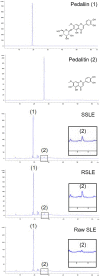Antioxidant activities of thermally treated Sesamum indicum L. leaf extracts and their inhibitory effects against growth and metastatic properties of human colon cancer cells
- PMID: 37781062
- PMCID: PMC10541370
- DOI: 10.1007/s10068-023-01408-9
Antioxidant activities of thermally treated Sesamum indicum L. leaf extracts and their inhibitory effects against growth and metastatic properties of human colon cancer cells
Abstract
The study aimed to investigate antioxidant activities of two different thermally treated sesame (Sesamum indicum L.) leaf ethanol extract, steamed sesame leaf extract (SSLE) and roasted sesame leaf extract (RSLE), and their inhibitory effects on uncontrolled growth and increased metastatic properties in human colon cancer cell lines. Both SSLE and RSLE contained pedaliin as the major polyphenol and its aglycon, pedalitin, as a minor component and exhibited radical scavenging activities and ferric reducing antioxidant power. SSLE and RSLE decreased growth of HT29 and HCT116 colon cancer cells, which was attributed to the induction of apoptosis and cell cycle arrest at either G2/M (by SSLE in HCT116) or S phase (by RSLE in HCT116). Furthermore, SSLE and RSLE inhibited migration and adhesion in both cell lines. These results indicate that thermally treated sesame leaves retained pedaliin content and exhibited antioxidant activities and inhibitory activities against the growth and metastatic properties of colon cancer cells.
Keywords: Antioxidant activity; Colon cancer cell; Pedaliin; Sesame leaf extract; Thermal treatment.
© The Korean Society of Food Science and Technology 2023. Springer Nature or its licensor (e.g. a society or other partner) holds exclusive rights to this article under a publishing agreement with the author(s) or other rightsholder(s); author self-archiving of the accepted manuscript version of this article is solely governed by the terms of such publishing agreement and applicable law.
Conflict of interest statement
Conflict of interestThe authors declare that there is no conflict of interests.
Figures





References
-
- Benzie IF, Strain JJ. The ferric reducing ability of plasma (FRAP) as a measure of "antioxidant power": the FRAP assay. Analytical Biochemistry. 1996;239:70–76. - PubMed
-
- Csepregi K, Kocsis M, Hideg E. On the spectrophotometric determination of total phenolic and flavonoid contents. Acta Biologica Hungarica. 2013;64:500–509. - PubMed
-
- Dat NT, Dang NH, le Thanh N. New flavonoid and pentacyclic triterpene from Sesamum indicum leaves. Natural Product Research. 2016;30:311–315. - PubMed
-
- Deng S, West BJ, Jensen CJ. Thermal degradation of flavonol glycosides in noni leaves during roasting. Advance Journal of Food Science and Technology. 2011;3:155–159.
-
- Dillard CJ, German JB. Phytochemicals: nutraceuticals and human health. Journal of the Science of Food and Agriculture. 2000;80:1744–1756.
LinkOut - more resources
Full Text Sources
